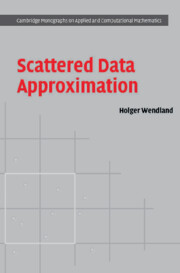Book contents
- Frontmatter
- Contents
- Preface
- 1 Applications and motivations
- 2 Haar spaces and multivariate polynomials
- 3 Local polynomial reproduction
- 4 Moving least squares
- 5 Auxiliary tools from analysis and measure theory
- 6 Positive definite functions
- 7 Completely monotone functions
- 8 Conditionally positive definite functions
- 9 Compactly supported functions
- 10 Native spaces
- 11 Error estimates for radial basis function interpolation
- 12 Stability
- 13 Optimal recovery
- 14 Data structures
- 15 Numerical methods
- 16 Generalized interpolation
- 17 Interpolation on spheres and other manifolds
- References
- Index
1 - Applications and motivations
Published online by Cambridge University Press: 22 February 2010
- Frontmatter
- Contents
- Preface
- 1 Applications and motivations
- 2 Haar spaces and multivariate polynomials
- 3 Local polynomial reproduction
- 4 Moving least squares
- 5 Auxiliary tools from analysis and measure theory
- 6 Positive definite functions
- 7 Completely monotone functions
- 8 Conditionally positive definite functions
- 9 Compactly supported functions
- 10 Native spaces
- 11 Error estimates for radial basis function interpolation
- 12 Stability
- 13 Optimal recovery
- 14 Data structures
- 15 Numerical methods
- 16 Generalized interpolation
- 17 Interpolation on spheres and other manifolds
- References
- Index
Summary
In practical applications over a wide field of study one often faces the problem of reconstructing an unknown function f from a finite set of discrete data. These data consist of data sites X = {x1, …, xN} and data values fj = f(xj), 1 ≤ j ≤ N, and the reconstruction has to approximate the data values at the data sites. In other words, a function s is sought that either interpolates the data, i.e. that satisfies s(xj) = fj, 1 ≤ j ≤ N, or at least approximates the data, s(xj) ≈ fj. The latter case is in particular important if the data contain noise.
In many cases the data sites are scattered, i.e. they bear no regular structure at all, and there is a very large number of them, easily up to several million. In some applications, the data sites also exist in a space of very high dimensions. Hence, for a unifying approach methods have to be developed which are capable of meeting this situation. But before pursuing this any further let us have a closer look at some possible applications.
Surface reconstruction
Probably the most obvious application of scattered data interpolation and approximation is the reconstruction of a surface S. Here, it is crucial to distinguish between explicit and implicit surfaces.
- Type
- Chapter
- Information
- Scattered Data Approximation , pp. 1 - 17Publisher: Cambridge University PressPrint publication year: 2004



